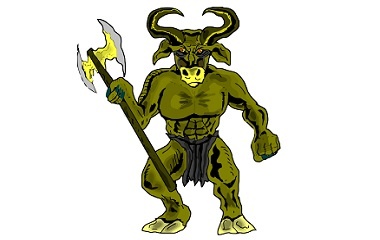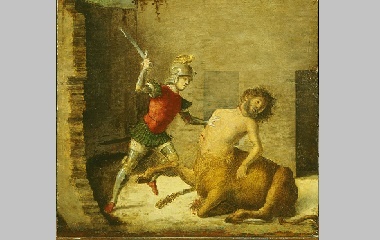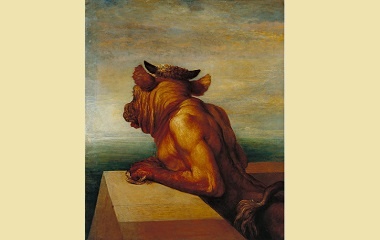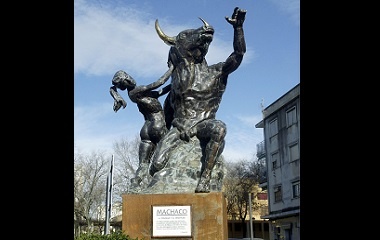What is the Minotaur?
The Minotaur is an ancient Greek monster, half-man and half-bull. The beast is most famous for dwelling inside a labyrinth, where he devoured 14 human sacrifices each year.
Characteristics
Physical Description
The ancient Greeks depicted the Minotaur as a creature with a man’s body and a bull’s head. His body was fully human, although his legs and arms were bulging with almost superhuman muscles. Beginning at his shoulders, he transformed into a bull with blue-black fur and sharp horns that could easily gore any human challenger. Sometimes, he was drawn with a bull’s tail as well.
During the Middle Ages, the Minotaur was only known to be “half-man, half-bull,” so he was drawn in much the same way as a centaur. He had a bull’s body, complete with all four legs. Where the bull’s neck would have begun, he transformed into a man. This misconception was eventually corrected, when more Greek texts were uncovered.
Over time, the Minotaur’s image has become less human and more bullish. Today, only his muscled stomach and arms remain human, although he does manage to walk upright on his bull’s legs.
Personality
The Minotaur has gone down in history as a bloodthirsty, mindless monster. He killed innocent, unarmed victims and feasted on their bodies. However, this description is given by the Athenians, who had a reason to hate the Minotaur: they were forced to supply victims for him to eat. It’s possible that the Minotaur was not so monstrous; he might even have been viewed as a hero by the people in his native kingdom, Minoa. Unfortunately, their records of the Minotaur were lost to time.
Stories about the Minotaur
Birth
King Minos was a son of the glorious god Zeus. Despite his pedigree, when Minos inherited the Minoan throne, his authority was disputed. He responded by sacrificing a bull to the gods, then asking the gods to send him another bull, which he vowed to sacrifice as well.
Deep in his ocean caverns, Poseidon heard about Minos’s offer and responded by sending a bull for the sacrifice. Coming from a god, the bull was incredibly powerful and beautiful. Its coat was dazzling white, and its muscles were like granite. The people of Minoa, including Minos, were enchanted by the bull, and Minos decided to spare the great beast and slaughter another in its place.
When Poseidon learned that Minos had broken his vow and kept the bull alive, he was furious. He decided to curse Minos, and he spent days brooding over a curse worthy of this offense. At last, he decided that he would make Minos’s wife, Paciphae, fall madly in love with the bull.
The next morning, Paciphae woke with a new longing in her heart. She couldn’t rest until she had the attention of the great bull, who was wandering freely around the Minoan countryside. Desperate, Paciphae enlisted the help of Minoa’s greatest inventor: Daedalus. Of course, Daedalus had a solution for his queen’s problem. He built a large wooden cow, covered it in cow skin, and placed it in one of the bull’s favorite pastures. Then he told Paciphae to hide inside the cow and wait for the bull to come by.
Eventually, the bull came into the pasture, searching for sweet green grass—but an even sweeter sight met his eyes. He was instantly enamored by the beautiful cow and decided to mate with her. Little did he know, he was actually mating with Paciphae, who was hidden inside the cow.
Weeks later, Paciphae gave birth to the Minotaur: half-man and half-bull.
Imprisonment
When King Minos saw the Minotaur and discovered his wife’s infidelity, he was infuriated. He ordered Daedalus to build a cage to imprison the child. Daedalus studied the child, and again, he came up with a solution. The child was already strong, and Daedalus predicted that he would grow up to be so powerful that he could rip through any cage. However, he did not seem to be very intelligent. Therefore, Daedalus decided to build a massive puzzle to trap the beast, and the first labyrinth was created. When it was finished, the Minotaur was placed in the center of the puzzle, where he had no chance of finding his way out.
Later, King Minos waged war against Athens and won. As a punishment, he demanded that Athens send seven young men and seven young women, each year, to be sacrificed. The young people were stripped of weapons and sent into the labyrinth, to feed the Minotaur.
Death
After Athens had sacrificed countless young men and women to the bloodthirsty Minotaur, Theseus, the prince of Athens, decided to put an end to the carnage. He volunteered to go with the next group of Athenians and kill the Minotaur.
When Theseus and the other Athenians arrived, they were met by King Minos and his daughter, Ariadne. The Athenians were stripped of weapons and tossed into a prison cell, where they would wait until morning came and then be sent into the labyrinth, while all of Minos celebrated.
Luckily for Theseus, Princess Ariadne had fallen in love with him at first sight. She snuck to his prison cell and gave him a sword and a ball of thread. The sword had obvious value, but the thread was more mysterious—until the princess explained that Theseus should tie it to the labyrinth’s door, then use it to find his way back out.
The next morning, the Athenians were forced into the labyrinth. Theseus told the rest of the group to stay by the door. Then, trailing the thread behind him, he began to make his way towards the center of the labyrinth. Eventually, he encountered the Minotaur. The battle between them was terrifying, but Theseus won. He then followed the thread back to the door and called to Princess Ariadne until she let him and the rest of the Athenians out.
Cultural Representation
Origin
The Minotaur comes from ancient Greek mythology. He was first discussed by Ovid in the 1st century BC. Virgil, Seneca, and Plutarch also contributed to the making of his legend. Paintings and mosaics of the battle between the Minotaur and Theseus have also been found dating back to the 6th century BC.
Modern Appearances
As one of ancient Greece’s most famous chimeras, the Minotaur has remained famous throughout the centuries. He can be seen in numerous Renaissance paintings and found in one of the levels of Dante’s Inferno. Later, the likes of Salvador Dali and Pablo Picasso created images of the legendary beast.
Today, the Minotaur is popular in fantasy and sci-fi. He appears in Dungeons and Dragons, Dr. Who, Wrath of the Titans and more.












that is a centaur in the 2nd picture, but still a great article
Lol this was so helpful
Thank you this helped me so much
When was this published? I really need to know for a project I’m doing.
thank you it really helped me on my project